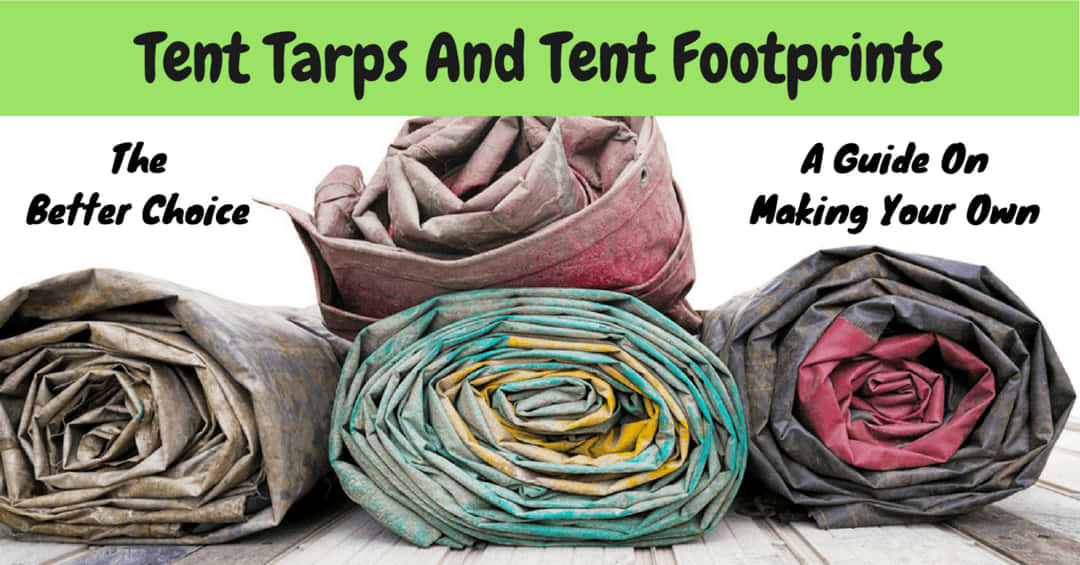
Have you ever camped on a rainy day? Have you experienced a flooding at the bottom of your tent during that day? Are you traumatized and didn’t want to go out and camp again? I did, too. In my early camping days, I solely relied on tarpaulin-like fly sheets to protect my little collapsible house.
I thought it’s just the one thing I need to protect me rain or shine, but on that fateful rainy evening, my tent started to flood, along with my stuff. It’s one of the worst camping days of my life. After that incident, I learned about a tarp under the tent or a “tent tarp” and a “tent footprint”.
A tarp laid on top of your tent is a “flysheet” while a “tent tarp” and a “tent footprint” are basically cloths laid underneath your tent to preserve the life of your expensive outdoor house and to also make you feel comfortable too.
Tents, especially the high quality and expensive ones are heavy duty, but it doesn’t mean that they’re indestructible. Your outdoor camping sessions on the beach, forest, and on fields will definitely take a toll on your tent.
It will surely have scratches, wears, and tears from rubbing against the rough ground, especially the bottom part of the tent.
Moreover, most tents are made from thin and durable fabrics to make them lightweight than the bulky ones. Personally, I think that no matter how expensive your tent is, its lightweight fabric will always be prone to tearing, water infiltration due to tearing, and consequently, mildews.
Mildews are the ultimate destroyer of camping tents. They usually set in whenever you fail to dry your tent after every use or if you subject the tent to flooding and rain for a long time. But what if it’s raining hard on your campsite or anywhere you set up the tent? What would you do to prevent the unpleasant mildew?
That’s where tent tarps and footprints enter. These tent floors are water-resistant, and they’re meant to protect the flooring of your tent from scratches, tears, wears, punctures, and water infiltration.
However, buying either a tent tarp or tent footprint may not be practical because they are pretty expensive. Some even cost more than the tent itself. Yes, my friends, the world is so unfair.
In this article, I’ll lay out the advantages of using a tent tarp and a tent footprint, the similarities and differences between the two, and finally, I’ll teach you how to make your own.
Why Would You Need a Tent Tarp or Footprint?
Most outdoor enthusiasts neglect the importance of using ground sheets to protect their tents because they’re confident enough with the performance of their tents.
When I was a newbie at camping, I didn’t see the need to use a tarp or footprint because my tent has already proven its quality through thick and thin.
But when I realized that I bought three tents in just two years (I’m a heavy camper), I finally came to the conclusion that I need to protect my investment to prolong its life. Thus I can save a couple of bucks from purchasing too frequently.
Tent tarps or footprints are an essential gear for every camper. Want to know its advantages? Read on.
It keeps the bottom of the tent dry
Again and again, the tent tarp’s primary function is to save your tent from getting wet. It reinforces the waterproofness of your tent. If it suddenly rains on your camping area, you don’t have to worry about anything.
A wet tent is very uncomfortable and will also cause mildew to breakout. If the tent’s dry, it will be easier to pack and will require little drying when you get home. Also, a dry tent will avoid ground debris from sticking to the bottom of the tent, making it easier to clean. Less hassle!
Adds insulation to the tent
Insulation is paramount especially if you plan to camp out in winter time or during colder climates. Since a regular tent’s fabric is too thin, it can’t protect your skin most of the time.
The tent tarp will add insulation on the bottom of the tent, preventing the cold ground from directly transferring the cold temperature in your tent. It also helps retain the warmer air inside your tent and prevent loss of heat.
Of course, you can’t keep warm all night with just using a tent tarp. There are other life-saving ways on keeping your tent warm.
Protection
Lastly, the tent tarp guarantees the protection of your precious tent from all the outdoor elements, including you. We’re not aware of it most of the time, but we are abusing our tents from too much use.
Just a simple turning and tossing inside the tent will cause bruises and scraping on the bottom of the tent. A prolonged usage of our tents without any sheet protection will expose it from further wearing and tearing.
Before all of this happens, buy or customize your own tent tarp before using your tent. It’s a way of protecting your investment.
Now that you know why you badly need to get a tent tarp or footprint.
What’s a Tent Tarp and a Tent Footprint?
1. Similarities
Function
Both tent tarps and footprints are laid underneath the tent as a ground cover.
They have multiple functions – protects the tent from scratches and tears, prevents water from coming into contact with the tent, acts as a guide when setting up the tent, provides a clean surface for packing the tent after use, and it can also double as a picnic cloth.
The have overlapping functions but that doesn’t mean that they’re both similar. Read on below to know their differences.
Material used
Tent tarps or tarpaulin is made from water-resistant and sturdy materials such as nylon, plastic, and silicone nylon.
Silicone nylon or “silnylon” is the common synthetic material used by manufacturers to construct tent tarps and other outdoor gears because of its light weightiness and tear strength.
Commercial tent tarps are equipped with poles and tent pegs, but you’ll need to fold or shape the tarp before you can use it as a ground sheet.
Most campers use tent tarps underneath the tent and also as a flysheet, the loose roofing on top of the tent.
2. Differences
Size
The only big difference I see is that commercial footprints are made to fit certain sizes of tents so you won’t have to go through the trouble of folding and cutting the material.
Furthermore, a tent tarp is a bit bulky while a tent footprint is light as a feather.
A tent tarp is ideal to use when car camping, and RVing but if you plan to backpack, you better use a tent footprint.
Price
Tent tarps are way cheaper compared to commercial tent footprints which cost half or more of the tent itself.
Being a cheapskate that I always am, and realizing that it’s very unpractical to purchase a sheet that costs half my tent, I will advise you to make your own tent footprint using a tarpaulin.
Resourcefulness is the key. You can always customize one!
Making Your Own Tent Tarp
I made my first tent tarp a few years back, and it’s still alive until now. I used it on every camping trip I had, and I can attest that it works like magic! It protected my fragile lightweight tent through thick and thin, and it also saved me from flooding.
I’ve said earlier that it’s wiser to make your own tarp tent rather than buy an expensive one. You just need a high-quality tarpaulin and a few other tools to get started. Any average person can easily follow the steps. There’s nothing too technical about it.
What you’ll need
- 1 10x 12 ft tarpaulin (Old tarpaulins If you have any)
- 4 grommets
- Nylon cords
- Scissors
- Marker
- Hammer
- Meter stick
- Grommet Plier
Step 1: Plan It All Out
First things first, measure the dimensions of your tent. You can look at the specs of your tent in the packaging, or you can lay it out and assemble it. Assembling the tent to measure its dimensions is better so that you’ll see the exact measurements and you can also see where you need to put allowances.
A 10 x 12 ft tarpaulin will fit any regular 4-6 person camping tent. If you have just a regular tent, go on and buy a 10×12 but if you have a family tent, measure it first before heading out.
Step 2: Assemble The Tent
Before assembling the tent, make sure that you are working in a spacious room because you’ll need space to measure and construct the tarp comfortably.
If it’s a bit crowded in your room, lay the tent on you outdoor lawn. Since the outdoors provide a better lighting, it will be wiser to work there. Also, make sure the ground is dry before starting.
Step 3: Get The Measurements
To get accurate measurements, lay the tarp beneath the tent. Get the meter stick and trace the outline of the tent floor using a marker. Be careful in measuring and keep the lines straight so when you cut later, it’ll be a perfect fit.
Trace the corners and the stake holes as well. It’s important that you mark exactly where the poles are.
Step 4: Trace a Half-Circle on the Entrance Part of the Tent
After tracing the dimensions and the corners of the whole tent, trace another half circle shape on the opening of the tent. The half circle should be at the center of the side where the entrance is.
Fold the tarpaulin lengthwise for a perfect half circle. It should be large enough, like half a meter long.
This circle will serve as additional flooring for your muddy shoes, bags, and other things. It’s an addition that I thought as wonderful and very valuable because it’ll keep you from losing your shoes and also protect it from further dirt and other outdoor elements.
Also, if you packed too many bags and other things, you can just put it outside to prevent crowding inside the enclosed space. Very helpful indeed!
Step 5: Cut Out the Tarpaulin
Okay, we’re now about to cut out the traced cloth. Get your scissors and begin cutting corners. It’ll be better if you can call your wife or friend in the next room to help you with the cutting since it’s a big piece of paper you have there.
Cut carefully along the corners and the semi-circle. We want a presentable tent tarp, do we?
Step 6: Trace another 2-3 inches away from the interior of the tarpaulin
Okay, so this is my main modification: trace another 2-3 inches away from the three sides of the tarpaulin (the part where the half circle is, is an exception). Leave out the half circle and the four corners where the poles are.
Fitting the tent tarp to the exact outline of the tent is a great mistake. I have discovered that the few extra inches on the sides will catch the rainfall (if any) and pool it on the sides and insides, making the tent tarp useless.
It’s primary function, as you can recall, is to keep the tent dry. The pooling of the water under the tent defeats the purpose that’s why it’s necessary to cut a few spaces away from the tent’s perimeter, so the tent tarp won’t catch any water to pool.
Step 7. Install the Grommets
The grommets will be fastened on the four corners of the tent where the poles should be. First, get some reinforcements for the grommet by using the excess tarp you’ve cut from the tent perimeter. Cut 8 medium-sized squares, measuring 2×2 inches.
Punch a hole in the four corners of the tarp where the poles are, together with the 8 squares using a grommet plier. Now get the tarp squares and the grommet. Fasten half of the grommet on the hole forcefully. After doing so, fit the other half of the grommet. Do this for all four corners.
Watch the video tutorial below for installing grommets on any fabric.
Step 8. Add the Nylon Cords
We’re down to the last step. Simply tie the nylon cord in the grommet, forming a loop. Don’t make a loop too big as this will loosen up the tent tarp when you attach it on the stake.
Conclusion
As I’ve said a number of times, tent tarps and footprints are very important for you and your tent. It has innumerable functions that will really benefit you.
Commercial tent tarps will cause you a great deal of money but why buy one when you can make one that has the same quality? You see, it’s never too hard to make a tent tarp.
It’s actually very easy and will only take you less than an hours to construct the whole thing. Isn’t it amazing to create something from scratch and see how beneficial it is? The secret is: resourcefulness.
Hey! Have you tried making your own tent tarps or footprints? How’d you do it? Does it have unique features too? Share your thoughts below!
Why don’t you share this article to help our fellow rain-drenched campers? Cheers!

I’m Cindy, a free-spirited outdoor enthusiast. Since childhood, Our family frequently goes on weekend camps and my father, who was a skilled hunter, used to teach my siblings and me valuable things about wildlife survival. I made this blog to share my knowledge, experiences, and tips.






